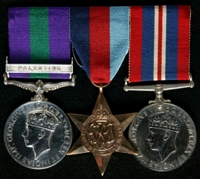
Photograph of John in Tameside Local Studies and Archives Centre. Reference: MRP/5D/043

(L to R) General Service Medal 1918-62 with clasp 'Palestine'; 1939-45 Star; 1939-45 War Medal
John was born on the 18th December 1911 in Northenden, Cheshire. He was baptised on the 29th February 1912 at St Wilfred's Parish Church in Northenden. His father was called Peter and his mother was Mary Hope. He had 5 older siblings; Frank, Albert E, Peter, Ena and Alma. We don't know whether he had any younger siblings.
When John was born his family lived at 19 Boat Lane in Northenden. Peter worked as a slater for a general contractor.
We don't know anything about John's early life. In early 1932 he decided to join the Army. He enlisted in the Manchester Regiment that February and was given the service number 3525392.
John began his service with training at the Regimental Depot in Ladysmith Barracks, Ashton-under-Lyne. He was a member of Mons Squad, under the command of Sergeant Walker. After he passed out of training in June he was posted to one of the Manchester Regiment's 2 battalions.
We believe John spent most of his career with the 1st Battalion. This was based in the UK until January 1934. It was then sent to the Caribbean. Half the battalion was based in Bermuda, and half went to Jamaica.
The 1st Battalion left the Caribbean for Egypt on the 26th September 1935. Tensions between the UK, who ruled Egypt, and Italy, who ruled neighbouring Libya, were rising during this period. The battalion took part in patrols of the border. After the situation calmed during early 1936 they returned to barracks in Moascar.
In mid 1937 the battalion began retraining and restructuring to become a mechanised machine gun battalion. They would now use the Vickers Machine Gun to support infantry units.
No sooner was this reorganisation finished than it had to be reversed. A rebellion had broken out amongst several of the Arab tribes living in Palestine, and the British needed more soldiers to bring it under control. The 1st Battalion left Egypt and Cyprus on the 14th January 1938, and served in Palestine as an infantry battalion.
The 1st Battalion was based in the area around the city of Acre. Their roles were to search for gangs of rebels, to patrol the countryside and to guard important areas against attack. From his medal, we know that John was a member of the battalion during this period.
On the 23rd September 1938 the 1st Battalion left Palestine for Singapore. When they arrived they began to build defences and train to resist an invasion. Their main role was to man pillboxes on the beaches of the island.
We don't know when John left the 1st Battalion. They were taken prisoner when Singapore fell to the Japanese on the 15th February 1942. Ten days after this, on the 25th, John was transferred to the Cheshire Regiment.
We don't know anything about John's service after this. In 1950 he donated a sum of money towards the reconstruction of the Manchester Regiment Chapel in Manchester Cathedral. He was thanked in the Manchester Regiment Gazette, which described him as an 'Arnhem casualty (50 per cent disabled)'. This tells us John had been wounded during the Battle of Arnhem in September 1944.
This battle was part of Operation Market Garden. It involved members of the Parachute Regiment dropping on the Dutch town of Arnhem to capture the bridge across the Rhine River. The British XXX Corps would advance as quickly as possible to meet them and secure the bridge. It was hoped that this would allow the Allies to cross into Germany and shorten the war.
The operation was not a success. XXX Corps was held up by strong German resistance. The British paratroopers held on as long as they could, but were eventually overwhelmed. Out of 10,000 British paratroopers around 1500 died and 6400 were taken prisoner.
The 2nd Battalion of the Cheshire Regiment fought with XXX Corps as it tried to reach Arnhem. We don't know whether John was a member of this unit, or whether he had transferred to the Parachute Regiment and landed in Arnhem.
When John made his donation he lived at 5 Balmoral Avenue in Stretford, Manchester. He later moved to Southport in Lancashire. He died there between July and September 1972, aged 60.
We don't know whether John ever married or had children, or whether he was entitled to any more medals for his service during the Second World War.




